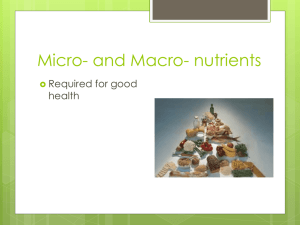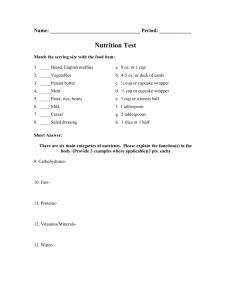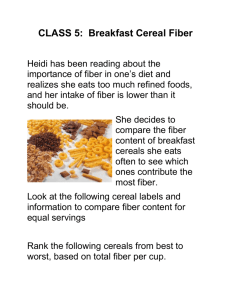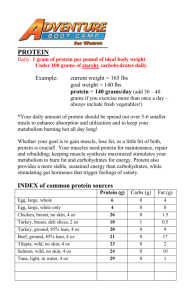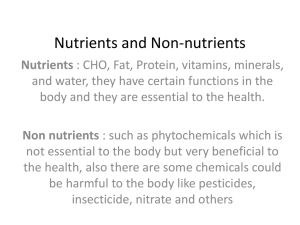Nutritional Approaches for the Treatment of Hyperlipidemia
advertisement
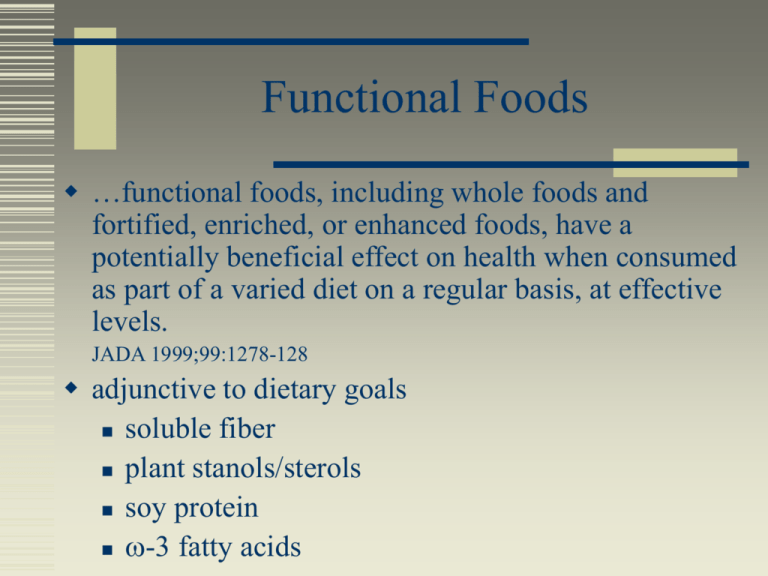
Functional Foods …functional foods, including whole foods and fortified, enriched, or enhanced foods, have a potentially beneficial effect on health when consumed as part of a varied diet on a regular basis, at effective levels. JADA 1999;99:1278-128 adjunctive to dietary goals soluble fiber plant stanols/sterols soy protein -3 fatty acids Soluble Fiber Viscous fibers from legumes, pectin, B-glucan from barley, oats, guar gum and psyllium husk Inverse association between soluble fiber, IHD mortality and MI (Jacobs DR; Am J Clin Nutr. 1998;68:248-257) Diet + soluble fiber Cholesterol 11% LDL-C 14% (in hypercholesterolemic subjects) LDL-C 10% (in normolipemic subjects) (Glore SR; J Am Diet Assoc. 1994;94:425-436) (Ripsin CM et al. JAMA 1992;267(24):3317-3325) Soluble fiber in foods Oat bran, 1/2 cup Oatmeal, 1/2 cup Cheerios, 1 1/2 cups Apple, 1 medium Banana, 1 medium Broccoli, 1 cup Baked potato w/skin, 1 small Kidney beans, 1/2 cup Split peas, 1/2 cup Psyllium seed husks, 3 tsp. 3.6 g 2.0 g 1.5 g 1.0 g 0.7 g 2.8 g 1.0 g 2.8 g 1.1 g 10 g (Psyllium data: Bell LP; JAMA 1989;261:3419-3423) Soluble fiber: mechanisms Depletion of bile acid pool Inhibition of hepatic cholesterol synthesis by short-chain FA produced by colonic fermentation Increased LDL-c catabolism Sat. fat and cholesterol intake due to lower fat choices higher in soluble fiber (Glore SR; J Am Diet Assoc. 1994;94:425-436) Summary Notes: Soluble Fiber Appears to lower LDL by up to 8% Adjunctive to other dietary and pharmacological measures to lower LDL Recommended as therapeutic option by ATP III: 10 to 25 g/day Plant sterols/stanols Structurally resemble cholesterol; not synthesized by humans Serum cholesterol: inhibit absorption of dietary and biliary cholesterol from small intestine by up to 65% Present in normal diet but not in therapeutic amounts Sitostanol (saturated sterol) most effective Commercial spreads: Benecol® (stanol) and Take Control® (sterol) (Hallikanienen M and Uustupa MI; Am J Clin Nutr. 1999;69:403-10) (Lichtenstein AH et al; Circulation 2001;103(8):1177-9) (Neils HAW et al. Atherosclerosis 2001;156:329-37) Plant sterol-containing margarines Plant stanol margarines Randomized, double-blind 153 subjects w/mild hypercholesterolemia 3g x 6 mo., then 2g sitostanol per day vs. control Dose:response relationship 12-mo. maximum: total cholesterol 10.2%; LDL-c 14.1% no change in HDL or triglycerides Values returned to baseline after 2 months (Miettinen TA et al. N Engl J Med. 1995;333:1308-12) Plant stanol margarines Hallikainen MA et al. J Nutr. 2000:130:767-776. Dose Choles P Value LDL-C P Value 0.8 2.8% 0.384 1.7% 0.892 1.6 6.8 <0.001 5.6 <0.05 2.4 10.3 <0.001 9.7 <0.001 3.2 11.3 <0.001 10.4 <0.001 (g/d) (%) (%) Investigators conclude: Differences between 1.6 vs. 2.4 and 3.2 g/d not significant (P=0.054-0.516).ApoB sig. At 0.8 g (P<0.001). dose not clinically important. Randomised controlled trial of use by hypercholesterolemic patients of a vegetable oil sterol-enriched fat spread Neil HAW et al. Atherosclerosis 2001;156:329-37 Double-blind, placebo-controlled crossover (2 periods x 8 weeks) 30 w with familial hypercholesterolemia on statins; 32 w/type IIa not on drug therapy Usual diet + 2.5 g plant sterols Significant reduction in total and LDL-cholesterol (10%) after 8 weeks No difference in response between patients on statins and those not on drug therapy Well tolerated and effective as an additive therapy in statin-treated familial hypercholesterolemia Plant stanol-containing margarines: 2-3 TB per day 1 TBSP Stanol ester (stanol) Benecol® Light Benecol® Regular 1.7 g (1 g) 1.7 g (1 g) Calories 45 80 Total fat 5g 9g Sat. fat/Trans fat 0.5 g/0 g 1 g/<1 g PUFA/MUFA 2 g/2.5 g 3 g/4 g Cholesterol 0 mg 0 mg Omega-3 Fatty Acids No recommendations by ATP III Populations with diets high in fish and other marine animals suggest high intakes of n-3 FA: low incidence of CVD Intake of EPA (C20:5n-3) and DHA (C22:6n-3) from seafood: may platelet aggregation and coronary spasm; accumulation of myocardial cytosolic calcium during ischemia (Siscovick DS et al. JAMA 1995;274(17):1363-67) (Drevon, CA Nutr Reviews 1992;50(4):38-45) Omega-3 Fatty Acids Lyon Diet-Heart Study: risk cardiac death by 76% w/diet enriched in -linolenic acid (18:3) (in some nuts, canola oil, flaxseed) (de Lorgeril M, et al. Circulation 1999;99:779-85) DART: 2033 men, post-MI add 300g fish per week (3 sv.) 29% in 2-year all-cause mortality; 33% in IHD mortality (Burr ML et al. Eur Heart J. 1992;13(2):166-70) Others find no association between fish intake and incidence of CHD (Ascherio A, et al. N Engl J Med. 1995;332:977-82; Gualler E, et al. J Am Coll Cardiol. 1995;25:287-94) Omega-3 Fatty Acids Case-control study: Are dietary long-chain n-3 PUFAs linked to vulnerability to life-threatening arrhythmias? Assessed intake of 35 types of seafood; estimated dietary EPA and DHA; and dietary fat Assayed RBC membrane FA levels (biomarker) Intake of 2.9 g n-3 PUFA (2 fish meals per month): 30% reduction in risk of primary cardiac arrest (OR 0.7; CI 0.6-0.9) Intake of 5.5 g n-3 PUFA (1 fish meals per week): 50% reduction in risk of primary cardiac arrest (OR 0.5; CI 0.4-0.8) May decrease vulnerability to ventricular fibrillation (Siscovick DS et al. JAMA 1995;274(17):1363-67) Omega-3 Fatty Acids % Change Subjects LDL-C TG n Normal +0.03 25.2 596(14) n-3/day (g) 5.3 Type IIa +2.3 20.3 37(3) 4.9 Type IIb +5.6 38.0 194(12) 6.4 Type IV/V +29.9 52.2 101(12) 8.0 (# studies) 5 – 8 g equivalent to 1-2 fish meals/day or 12 to 20 1-g fish oil capsules. Adapted from Harris WS. Am J Clin Nutr. 1997;65(suppl):1645S-1654S Summary notes: Omega-3 Fatty Acids Not addressed by ATP III, possibly due to equivocal data Most powerful effect is on triglycerides Food sources (fish and seafood, certain oils) most often preferable to supplements May reduce risk for coronary events or mortality Soy protein High quality protein, low in saturated FA Good source of phytoestrogens: isoflavones believed to be most active Substitute soy for animal protein: cholesterol ? Protective mechanisms: Inhibition of LDL oxidation Maintenance of blood vessel flexibility Prevention of thrombosis (Platt R. Prev Cardiol. 2000;3:83-87) Soy protein: LDL by 5% Goal: 25 to 30 g soy protein/day Product Soy burger Tofu, 1/3 block Tempeh, ½ cup Soy milk, 1 cup Soybeans, ½ cup Protein (g) 18 15 15.7 6.6 14.3 Sample Eating Pattern (1500 kcals, 23% fat, 50% CHO, 11 g soluble fiber, 3.4 g stanol esters) Breakfast 1 cup oatmeal 1 TB Benecol® Light 1 oz. raisins 4 oz. Skim milk 1 small orange Lunch 2 oz. Harvest Burger® (soy) 2 tsp. Mayonnaise 2 leafs romaine lettuce 2 slices wholegrain bread 1 small apple 3 oz. Baby carrots 4 oz. Skim milk Dinner 3 oz. Filet of sole ½ cup brown rice 1 cup broccoli 2 tsp. canola oil 1 cup strawberries Snack 1 slice wholegrain bread 1 TB Benecol® Light 8 oz. Skim milk Summary Cardioprotective changes through individualized eating patterns can be achieved Most successful with team/behavioral approach Nutrition professional facilitates translation of clinical recommendations into changes in eating behavior by fully assessing risk factors and tailoring to fit medical and lifestyle needs; other behavioral/activity professionals have key roles Nutritional + other lifestyle changes alone may be sufficient to normalize lipids; approaches are adjunctive to pharmacological rx, when needed, and may allow lower dose More investigation needed on ratio of CHO:fat and type(s) of fat to optimize risk reduction Selected functional foods are promising


